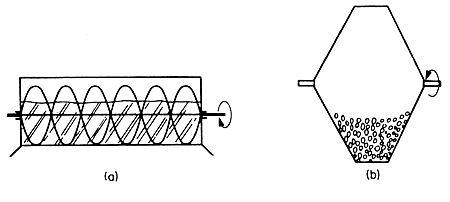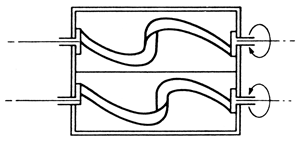Various baffles
can be used and the placing of these can make very considerable differences
to the mixing performances. It is tempting to relate the amount of
power consumed by a mixer to the amount of mixing produced, but there
is no necessary connection and very inefficient mixers can consume
large amounts of power.
Powder and Particle Mixers
The essential feature
in these mixers is to displace parts of the mixture with respect to
other parts. The ribbon blender, for example, shown in Fig. 12.2(a) consists of a trough in which rotates a shaft with two open helical
screws attached to it, one screw being right-handed and the other left-handed.
As the shaft rotates sections of the powder move in opposite directions
and so particles are vigorously displaced relative to each other.

Figure 12.2 Mixers (a) ribbon blender, (b) double-cone mixer
A commonly used
blender for powders is the double-cone blender in which two cones are
mounted with their open ends fastened together and they are rotated
about an axis through their common base. This mixer is shown in Fig.
12.2(b).
Dough and Paste Mixers
Dough and pastes
are mixed in machines that have, of necessity, to be heavy and powerful.
Because of the large power requirements, it is particularly desirable
that these machines mix with reasonable efficiency, as the power is
dissipated in the form of heat, which may cause substantial heating
of the product. Such machines may require jacketing of the mixer to
remove as much heat as possible with cooling water.
Perhaps the most
commonly used mixer for these very heavy materials is the kneader which
employs two contra-rotating arms of special shape, which fold and shear
the material across a cusp, or division, in the bottom of the mixer.
The arms are of so-called sigmoid shape as indicated in Fig.
12.3.

Figure 12.3 Kneader
They rotate at differential speeds, often in the ratio of nearly 3:2.
Developments of this machine include types with multiple sigmoid blades
along extended troughs, in which the blades are given a forward twist
and the material makes its way continuously through the machine.
Another
type of machine employs very heavy contra-rotating paddles, whilst
a modern continuous
mixer consists of an interrupted screw which oscillates with both rotary
and reciprocating motion between pegs in an enclosing cylinder. The important
principle in these machines is that the material has to be divided and
folded and also displaced, so that fresh surfaces recombine as often
as possible.
 Mixing > SUMMARY,
PROBLEMS Mixing > SUMMARY,
PROBLEMS
 Back
to the top Back
to the top |
![]() Liquid
Mixers
Liquid
Mixers![]() Powder and Particle Mixers
Powder and Particle Mixers ![]() Dough and Paste Mixers
Dough and Paste Mixers 

